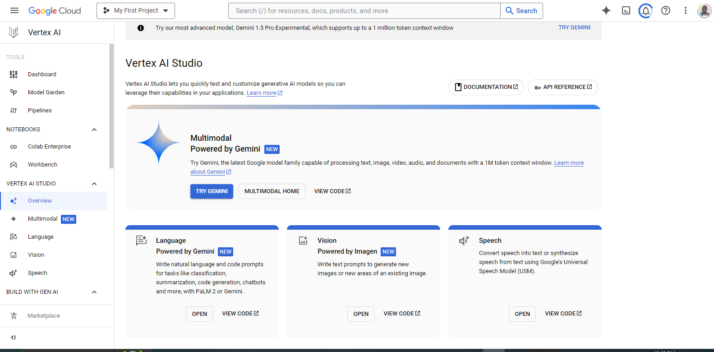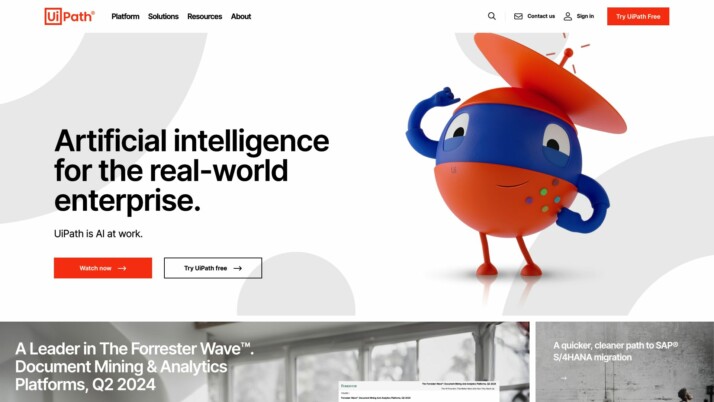Vertex AI vs. UiPath: Comparing AI and Automation Powerhouses
AI platforms have transformed how businesses operate, innovate, and compete. Vertex AI vs. UiPath, and SmythOS offer unique approaches to harnessing AI’s power, each with distinct strengths and capabilities. This comparison explores how these platforms tackle key challenges in AI development, deployment, and automation. We’ll examine their core features, ease of use, and suitability for various business needs. Whether you’re a developer seeking advanced AI tools, a business leader looking to streamline operations, or an entrepreneur exploring AI’s potential, this analysis will help you navigate the complex landscape of AI solutions and choose the platform that best aligns with your goals.
Vertex AI Overview
Vertex AI streamlines machine learning model development and deployment on Google Cloud. The platform unifies data engineering, data science, and ML engineering workflows, enabling seamless collaboration through a comprehensive toolset.


Screenshot from Vertex AI studio.
Vertex AI’s standout feature is its Gemini multimodal generative AI model. Gemini processes text, images, audio, and video inputs, powering advanced applications like chatbots and content generation. The platform’s Model Garden offers a curated selection of pre-trained models, including Google’s proprietary offerings and select open-source options. Users can fine-tune these models to optimize performance for specific use cases.
Vertex AI’s standout feature is its Gemini multimodal generative AI model. Gemini processes text, images, audio, and video inputs, powering advanced applications like chatbots and content generation.
For enterprise deployments, Vertex AI provides robust MLOps capabilities. The Model Registry centralizes version control, while the Feature Store efficiently serves machine learning features at scale. Built-in monitoring tools track model performance in production environments.
While Vertex AI offers powerful capabilities, it requires coding knowledge for most tasks. This may present a barrier for non-technical users seeking to leverage AI. Additionally, the platform’s tight integration with Google Cloud services could limit flexibility for organizations using multi-cloud or hybrid cloud architectures.
Vertex AI positions itself as an end-to-end solution for organizations building and deploying AI at scale. Its comprehensive feature set and integration with Google Cloud make it a strong contender for enterprises already invested in the Google ecosystem. However, companies prioritizing no-code solutions or requiring more flexible deployment options may need to evaluate alternatives.
UiPath Overview
UiPath delivers an enterprise-grade automation platform for organizations seeking to streamline operations through intelligent software robots. The platform empowers both technical and business users to discover automation opportunities, build robust workflows, and deploy digital workers at scale.
At its core, UiPath offers a suite of tools for robotic process automation (RPA), enabling companies to automate repetitive tasks across diverse applications and systems. The platform excels in automating structured workflows, particularly in areas like finance, human resources, and customer service. UiPath’s strength lies in its ability to mimic human interactions with software interfaces, making it ideal for organizations with legacy systems or complex IT environments.


Screenshot of UiPath Website
UiPath delivers an enterprise-grade automation platform for organizations seeking to streamline operations through intelligent software robots.
UiPath’s visual development environment allows users to create automation workflows through drag-and-drop functionality, reducing the need for extensive coding. This approach democratizes automation, enabling business analysts and operations teams to contribute directly to digital transformation efforts. For more complex scenarios, UiPath provides advanced scripting capabilities, giving developers the flexibility to create sophisticated automations.
While UiPath shines in process automation, it faces challenges in more open-ended AI applications. The platform’s focus on structured workflows means it may not be the ideal choice for organizations primarily seeking conversational AI or advanced problem-solving capabilities. Additionally, the learning curve for fully leveraging UiPath’s extensive feature set can be steep, potentially requiring significant training and resource investment.
UiPath integrates with a wide range of enterprise systems and cloud services, facilitating seamless data exchange and process orchestration across an organization’s technology stack. The platform also offers robust governance and security features, crucial for enterprises dealing with sensitive data or operating in regulated industries. As automation needs evolve, UiPath continues to expand its capabilities, incorporating machine learning and AI to enhance the intelligence and adaptability of its software robots.
Feature Comparison
Vertex AI and UiPath offer distinct approaches to AI and automation, with key differences in their core capabilities and target use cases. Vertex AI provides a comprehensive machine learning platform focused on model development and deployment, while UiPath specializes in robotic process automation (RPA) for streamlining business workflows.
Vertex AI excels in areas like multimodal AI, offering advanced models like Gemini that can process text, images, audio, and video inputs. This capability enables sophisticated applications such as chatbots and content generation tailored to specific industries. In contrast, UiPath’s strength lies in automating structured business processes, particularly excelling at mimicking human interactions with software interfaces. This makes UiPath ideal for organizations looking to automate repetitive tasks across legacy systems and complex IT environments.
A significant gap exists in the no-code/low-code capabilities between the two platforms. UiPath provides a visual development environment that allows business users to create automation workflows through drag-and-drop functionality, democratizing automation within organizations. Vertex AI, while powerful, requires more technical expertise and coding knowledge for most tasks, potentially limiting its accessibility to non-technical users seeking to leverage AI capabilities.
Feature Comparison Table
| Vertex AI | UiPath | SmythOS | |
|---|---|---|---|
| CORE FEATURES | |||
| AI Agents | ✅ | ❌ | ✅ |
| Hosted Agents (Dev, Production) | ✅ | ❌ | ✅ |
| No-Code Options | ❌ | ❌ | ✅ |
| Memory & Context | ✅ | ❌ | ✅ |
| Autonomous Agents | ✅ | ❌ | ✅ |
| Explainability & Transparency | ✅ | ❌ | ✅ |
| Multimodal | ✅ | ❌ | ✅ |
| Problem-Solving Capabilities | ✅ | ❌ | ✅ |
| Multi-Agent Collaboration | ✅ | ❌ | ✅ |
| Audit Logs for Analytics | ❌ | ✅ | ✅ |
| Work as Team | ✅ | ❌ | ✅ |
| SECURITY | |||
| Constrained Alignment | ✅ | ❌ | ✅ |
| COMPONENTS | |||
| Foundation AIs | ✅ | ❌ | ✅ |
| Huggingface AIs | ❌ | ❌ | ✅ |
| Zapier APIs | ❌ | ❌ | ✅ |
| Classifiers | ✅ | ❌ | ✅ |
| Data Lakes | ✅ | ❌ | ✅ |
| DEPLOYMENT OPTIONS (EMBODIMENTS) | |||
| Deploy as API | ✅ | ❌ | ✅ |
| Deploy as Webhook | ✅ | ❌ | ✅ |
| Staging Domains | ✅ | ❌ | ✅ |
| Production Domains | ✅ | ❌ | ✅ |
| Deploy as Site Chat | ✅ | ❌ | ✅ |
| Deploy as Scheduled Agent | ✅ | ❌ | ✅ |
| Deploy as GPT | ✅ | ❌ | ✅ |
| DATA LAKE SUPPORT | |||
| Hosted Vector Database | ✅ | ❌ | ✅ |
| Sitemap Crawler | ❌ | ❌ | ✅ |
| YouTube Transcript Crawler | ❌ | ❌ | ✅ |
| URL Crawler | ✅ | ❌ | ✅ |
| TXT File Support | ✅ | ❌ | ✅ |
Best Alternative to Vertex AI and UiPath
SmythOS stands out as the superior alternative to Vertex AI and UiPath, offering a comprehensive AI automation platform that combines the best of both worlds. We’ve designed SmythOS to empower users with advanced AI capabilities while maintaining exceptional ease of use. Our platform bridges the gap between sophisticated machine learning and practical business automation, providing a versatile solution for a wide range of industries and use cases.
Unlike Vertex AI, which requires considerable technical expertise, SmythOS features an intuitive drag-and-drop interface that democratizes AI development. This visual builder allows users of all skill levels to create complex AI workflows without extensive coding knowledge. We’ve also incorporated pre-built API integrations and templates, significantly reducing setup time and allowing users to focus on innovation rather than implementation details.
SmythOS features an intuitive drag-and-drop interface that democratizes AI development… allowing users of all skill levels to create complex AI workflows without extensive coding knowledge.
While UiPath excels in robotic process automation, SmythOS takes automation to the next level with its support for autonomous AI agents. These agents can operate independently, performing tasks and interacting with APIs and other agents to solve complex problems. Our platform’s multi-agent collaboration feature enables teams of AI agents to work together, enhancing efficiency and scalability in ways that UiPath’s traditional RPA approach cannot match.
SmythOS shines in its deployment flexibility, offering options that neither Vertex AI nor UiPath can fully match. We support deployment as APIs, webhooks, chatbots, scheduled agents, and even integration with platforms like ChatGPT. This versatility ensures that AI solutions built with SmythOS can be seamlessly integrated into existing systems and workflows, maximizing the value of AI across an organization.
SmythOS shines in its deployment flexibility… We support deployment as APIs, webhooks, chatbots, scheduled agents, and even integration with platforms like ChatGPT.
By choosing SmythOS, users gain access to a platform that combines the advanced AI capabilities of Vertex AI with the automation prowess of UiPath, all wrapped in a user-friendly package. Our commitment to continuous innovation and comprehensive support ensures that SmythOS remains at the forefront of AI automation technology, providing a future-proof solution for businesses looking to harness the full potential of AI.
Conclusion
Vertex AI, UiPath, and SmythOS offer distinct approaches to AI and automation, each with unique strengths. Vertex AI excels in advanced machine learning and multimodal AI capabilities, while UiPath shines in robotic process automation for structured workflows. However, SmythOS emerges as the superior choice for organizations seeking a versatile, user-friendly AI development platform.
SmythOS stands out with its intuitive drag-and-drop interface, enabling users to create sophisticated AI agents without extensive coding knowledge. This democratization of AI development sets it apart from Vertex AI’s more technical approach. Unlike UiPath’s focus on structured processes, SmythOS offers flexibility for a wide range of AI applications, from chatbots to complex problem-solving agents.
The platform’s extensive integration ecosystem, supporting over 300,000 integrations, surpasses both Vertex AI and UiPath in versatility. SmythOS’s ’Create Once, Deploy Anywhere’ philosophy allows seamless deployment across various platforms, including popular services like Google Vertex, Microsoft Copilot, and Amazon Web Services Bedrock.
For businesses looking to harness AI’s full potential, SmythOS offers a compelling solution. Its comprehensive feature set, including multi-agent orchestration, versatile deployment options, and pre-built templates, empowers organizations to innovate rapidly and efficiently. We invite you to explore our diverse range of AI-powered agent templates and experience how SmythOS can transform your AI development process. Get started with SmythOS today and unlock the future of AI-driven productivity for your organization.
Last updated:
Disclaimer: The information presented in this article is for general informational purposes only and is provided as is. While we strive to keep the content up-to-date and accurate, we make no representations or warranties of any kind, express or implied, about the completeness, accuracy, reliability, suitability, or availability of the information contained in this article.
Any reliance you place on such information is strictly at your own risk. We reserve the right to make additions, deletions, or modifications to the contents of this article at any time without prior notice.
In no event will we be liable for any loss or damage including without limitation, indirect or consequential loss or damage, or any loss or damage whatsoever arising from loss of data, profits, or any other loss not specified herein arising out of, or in connection with, the use of this article.
Despite our best efforts, this article may contain oversights, errors, or omissions. If you notice any inaccuracies or have concerns about the content, please report them through our content feedback form. Your input helps us maintain the quality and reliability of our information.
